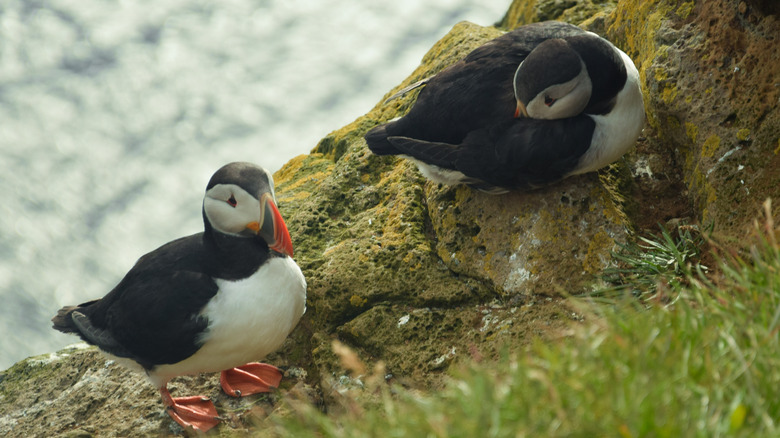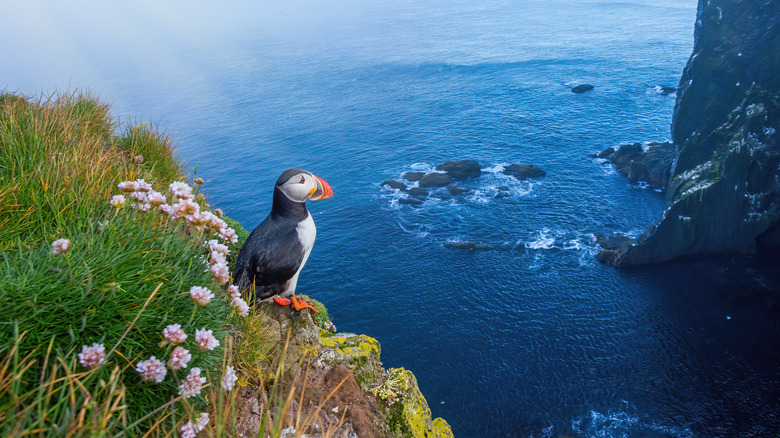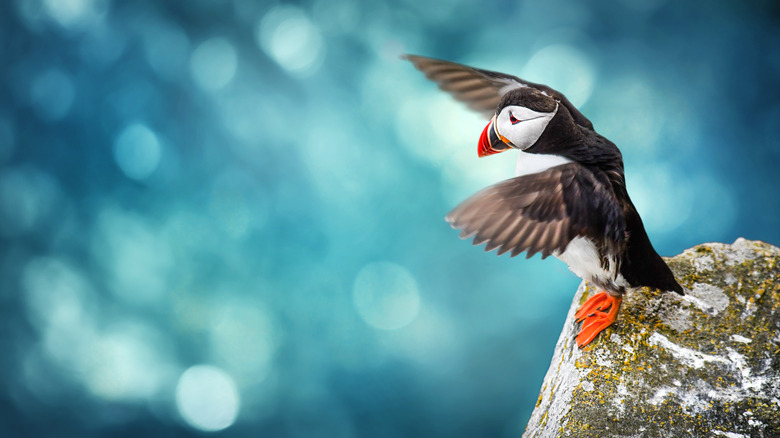The Real Reason People Collect And Throw Baby Puffins Off Cliffs Once A Year
It sounds like a cruel, tasteless joke at first. How could anyone consider throwing an adorable baby puffin, also known as pufflings, off a cliff? As it turns out, the act is not only an Icelandic tradition, it's an important ecological activity that keeps the puffin population safe and thriving year after year. According to the National Audubon Society, puffins lay one egg at a time, which undergoes an incubation process for approximately six weeks. Once the puffling hatches, it remains in its burrow nest on high cliffs for around another six weeks. Both parents take turns bringing the chick food until it reaches its full size and is able to fly away from the nest and begin its life on the seas. They are uniquely equipped for this, with their waterproof feathers and abilities to drink salt water and hunt fish.
Eventually, the birds come back to land to breed, which per Audubon's Project Puffin doesn't happen until a puffin is about five years old. Audubon also notes that puffins breed in colonies between April and August and then tend to disperse between August and April, which makes studying them difficult. Iceland's Westman Islands has an annual "puffling season," occurring when the 6-week-old chicks are ready to leave their nest and fly. They need assistance at this stage due to the modern world's reliance on electricity.
Puffling patrols save birds' lives every year
As reported by NPR, puffins leaving their nests for the ocean have historically done so by following the light of the moon. Unfortunately, modern electric lights can confuse the fledglings, and they sometimes crash-land in residential areas of Iceland's Western Islands, or Vestmannaeyjar. It's become tradition for the residents of the region to go on "puffling patrol" in town each August and September and look for birds who have lost their way between nest and ocean. People collect the birds using flashlights and boxes filled with grass and bring them to the cliffs overlooking the town, where the pufflings can get back on course and fly to the water.
Kyana Sue Peters learned about puffling season while vacationing in Iceland and has since participated twice. It's not actually necessary to throw the chicks off the cliff; one can place the bird on the ground and let it take off on its own schedule. However, per Peters, "I don't see many people do this. Some people kind of hold it like a football with the wings out and then they shoot it — but you know, it's not aggressive, [the pufflings] are ready to go." Puffling rescuers can often find between four and 10 chicks in one evening. Scientists encourage people to log the numbers and weights on a special website.
Light pollution also affects birds
Rodrigo A. Martínez Catalán of Náttúrustofa Suðurlands, also known as the South Iceland Nature Research Center, spoke with NPR about the annual puffling rescue and release. He noted that it's become an essential part of puffin survival. Puffin chicks are already in short supply due to the birds incubating just one egg at a time and often taking years off from reproducing entirely. He said, "If you have one failed generation after another after another after another, the population is through, pretty much." Other human-made threats to puffin populations, per Audubon Puffin Project, include over-fishing and not leaving enough food for the puffins, over-hunting the birds for their feathers and for food, uncontrolled tourism, the introduction of predators such as foxes and rats to puffin habitats, and oil spills in the ocean weighing down feathers. In fact, as Kyana Sue Peters wrote for Inspired By Iceland, boats employ large nets during puffling season to capture birds that end up in the harbor so they can be brought to the cliffs for release.
Electric lights confuse other species of birds during their migrations as well. Audubon has a Lights Out Program encouraging people to turn off the excess lighting. Birds tend to migrate at night and bright artificial light can cause birds to become disoriented and crash into buildings, fly off their migration path and become lost, and expend too much energy because of confusion and stress brought on by bright lights, which makes them too exhausted to fly.


